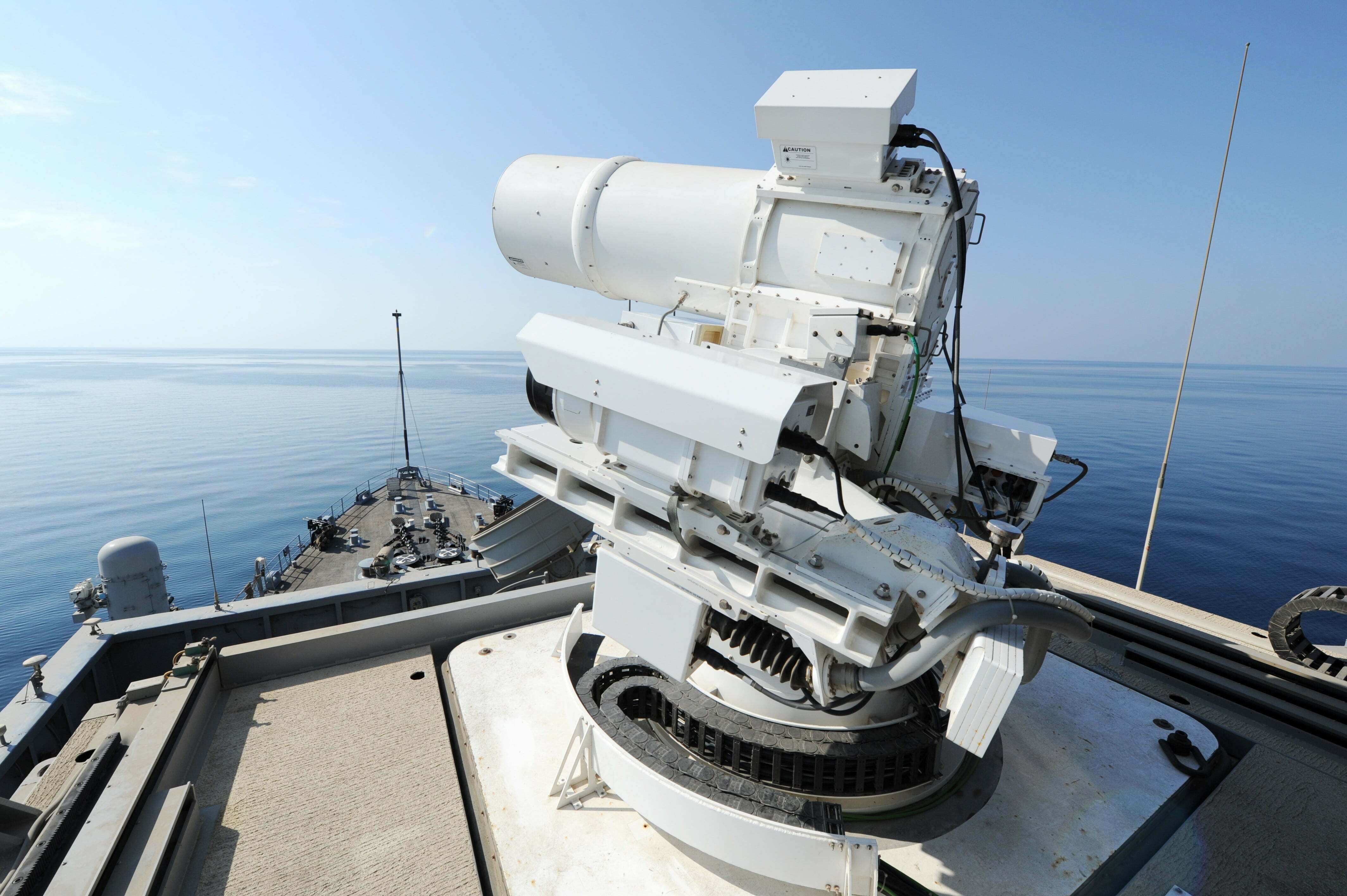2016-10-05 By Robbin Laird and Ed Timperlake
We have interviewed Rear Admiral Manazir before when he was Director, Air Warfare, but this is our first interview with him after he has become Director, Warfare Systems (N9).
Manazir currently serves as the Deputy Chief of Naval Operations for Warfare Systems (OPNAV N9) on the staff of the Chief of Naval Operations.
In this capacity, he is responsible for the integration of manpower, training, sustainment, modernization and procurement of the Navy’s warfare systems.
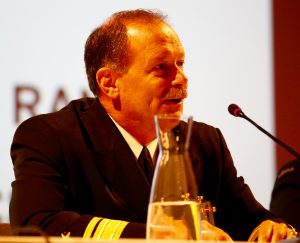
Rear Admiral Manazir recently returned from Australia where he was the lead speaker in the Williams Foundation Seminar on new approaches to air-sea integration.
It is clear that the US Navy’s focus on shaping a distributed lethality fleet is shared by core allies.
Rear Admiral Manazir highlighted the kill web approach as a way to shape more effective integration of forces and convergence of efforts.
The kill chain is a linear concept which is about connecting assets to deliver fire power; the kill web is about distributed operations and the ability of force packages or task forces to deliver force dominance in an area of interest.
It is about building integration from the ground up so that forces can work seamlessly together through multiple networks, rather than relying on a single point of failure large network.
https://sldinfo.com/rear-admiral-manazir-in-australia-allied-convergence-on-the-kill-web/
In this interview, the OPNAV N9 discussed how he sees the way ahead, including the inclusion of directed energy weapons within the fleet.
Question: The new Chief of Staff of the USAF, General Goldfein, seems to be focused on issues in ways that the CNO is as well.
For example, General Goldfein focused on the moral imperative of training for the high end fight.
He has highlighted the importance of innovation in C2, including distributed C2.
How do you view the USAF and USN overlap?
Rear Admiral Manazir: The question that drives my response to the challenge is how do we achieve distributed effects across all domains in the battlespace?
We are working closely with General Goldfein through various Service interaction groups; most effectively at the highly classified level.
We talk about issues that are common to our Services on a regular basis.
The core commonality between the two is that both are expeditionary services.
When we get into the battle area, Air Force assets can strike, reset, and strike again.
Naval forces operating in the maritime domain provide persistence.
If you combine Air Force and Naval combat capabilities you have a winning combination.
If you architect the joint force together, you achieve a great effect.
It is clear that C2 (command and control) is changing and along with it the CAOC (Combined Air and Space Operations Center).
The hierarchical CAOC is an artifact of nearly 16 years of ground war where we had complete air superiority; however, as we build the kill web, we need to be able to make decisions much more rapidly.
As such, C2 is ubiquitous across the kill web.
Where is information being processed?
Where is knowledge being gained?
Where is the human in the loop?
Where can core C2 decisions best be made and what will they look like in the fluid battlespace?
The key task is to create decision superiority.
But what is the best way to achieve that in the fluid battlespace we will continue to operate in?
What equipment and what systems allow me to ensure decision superiority?
We are creating a force for distributed fleet operations.
When we say distributed, we mean a fleet that is widely separated geographically capable of extended reach.
Importantly, if we have a network that shares vast amounts of information and creates decision superiority in various places, but then gets severed, we still need to be able to fight independently without those networks.
This requires significant and persistent training with new technologies but also informs us about the types of technologies we need to develop and acquire in the future.
Additionally, we need to have mission orders in place so that our fleet can operate effectively even when networks are disrupted during combat; able to operate in a modular-force approach with decisions being made at the right level of operations for combat success.
Question: When you were in Australia, you highlighted that the Australians and British, who were participating with you in the Williams Foundation Conference, were on the same page with regard to the way ahead.
How important is that for the US Navy and Marine Corps team?
Rear Admiral Manazir: Crucial.
In effect, when we can operate together in this new environment and work from the same page, we can support core allies or allies can support us in the battlespace.
We can function as each other’s wingman.
We are moving from a platform-centric mindset to a capability-centric mindset.
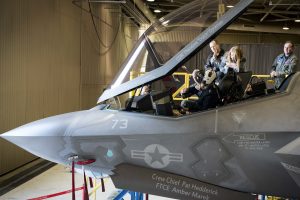
For instance, when we talk about the F-35 we are focused not simply on the platform but how that F-35 empowers and fits into the distributed networks or kill webs.
It is the outcome and effect we are focused on.
If we’re going to fight next to each other, the force (as an evolving distributed capability) has to understand how to employ their weapons systems, including how to best leverage the F-35, rather than just relying on the pilot that is flying the F-35 understanding what it can do.
Question: There clearly is a challenge between the force and technology moving into a distributed direction and historical legacies of slow moving hierarchical decision making.
How would you describe this challenge?
Rear Admiral Manazir: The rules of engagement (ROE) need to keep up with the technology.
An F-35 is going to have electronic means that can affect somebody a long way away.
We didn’t have those electronic means before, and so the ROE should be able to allow us to employ weapons based on the technology that we have.
To keep up with technology is a key point, but it goes all the way back to when the bad guys are successful snipping parts of the network, you need to have mission orders that are effective and I am confident we are training with that in mind.
Question: Recently, you made a speech on directed energy and discussed the way ahead for the US Navy in this very promising area.
What is your perspective?
Rear Admiral Manazir: Any vehicle which can be a source of space, weight, power and cooling, with enough capability to generate and hold the power needed to employ directed energy weapons can be a useful platform for directed energy in the future fight.
More generally, directed energy weapons are part of our overall transformation in the weapons enterprise. Directed energy weapons are fifth generation weapons. Directed energy weapons, coupled with other new types of weapons, are critical to empowering a distributed force.
We need directed energy weapons as adjuncts to our current kinetic weapon systems in order to turn the cost curve our way. For example, we shoot down cruise missiles that cost a couple hundred thousand dollars with $3 million defensive missiles.
Our weapons are very effective, but we shoot a $3 million round every time we use them.
We are working to build synergy among electronic attack, directed energy and kinetic weapons to shape an interactive and integrated capability for the distributed force.
We are moving towards funding a directed energy plan which would enable us to move towards implementing interim directed energy laser capability between now and 2020.
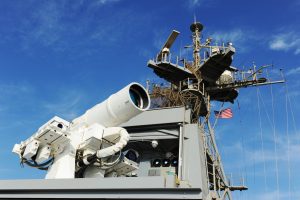
There’s a 30-kilowatt laser on USS PONCE right now.
It’s in the Arabian Gulf and it works.
It works very well.
As you know, lasers can be used for communications. They can be used for ISR.
They can obviously be used for non-kinetic effects.
In order to have the higher-end kinetic effect, you have to have the space for the weight of the laser itself, the power for it, and then the cooling-wherever the source.
Obviously, with a ship in the water, you have an unlimited source of cooling water.
Then, in order to have a very, very deep magazine for a laser shot, you either have to have a constant source of fairly high electrical power, or you have to have a very large battery.
We are not waiting until we have what many see as the ultimate goal, a one megawatt laser weapon; we would like to build capability incrementally.
Over time we will be able to field higher and higher power laser weapons.
It is about putting it into the fleet and evolving the capability; it is not about waiting until we have the optimal weapon.
We need not just the weapon, but the training and the tactics shaped by the fleet to provide inputs to how best to integrate the capability into the force.
Question: If we return to the non-platform centric point, this applies to directed energy weapons as well. As you add the tool you adjust the entire fleet to evolving operational capabilities.
How do you view directed energy weapons in this sense?
Rear Admiral Manazir: Directed energy weapons are only a part of this new way of thinking.
The key is continually evolving combinations of capabilities that enhance the defensive and offensive power of the platforms that you put into the kill web.
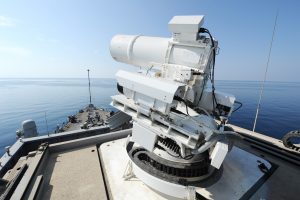
We are very focused on the evolving man-machine relationship, and the ability of manned and unmanned systems, as well as kinetic and non-kinetic systems, to deliver a broader spectrum of capability to the force.
We are aiming to use the machine for the OO (Observe-Orient) part of the OODA (Observe-Orient-Decide-Act) Loop and optimize our human capabilities to do the DA (decide-act).
Fighter pilots have always been “thinking aviators” but we are adjusting what we expect from them as they become key nodes and crucial enablers in the kill web.
Becoming a Top Gun pilot in this world will be quite different than in the legacy one.
Question: We have written about software upgradeability as a key element for shaping the way ahead for 21st century air systems, such as in the Wedgetail, the P-8, Triton and the F-35.
How do you view the importance of such an approach?
Rear Admiral Manazir: Common software upgradeability is an essential element, especially to be able to alter the web or portions of the web at the speed of technology to be able to outmatch our adversaries in an evolving threat environment.
We are working to shape such a cross-cutting capability throughout the fleet so that we can have interactive modernization, even machine learning and cognitive processes which can be done rapidly and cost effectively.
This can only be done through a software-defined process.
We need to have open systems architecture; truly open systems, where there is middleware that enables the creation of multiple apps to provide innovative responses to evolving threats.
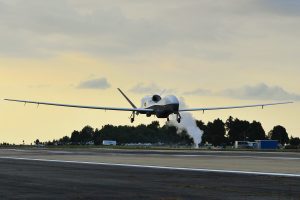
We are learning as we go: Navy Integrated Fire Control-Counter Air (NIFC-CA) is a system of systems approach, which is a huge engineering challenge. Here you have to connect different proprietary systems retroactively.
They were all created under different sets of standards, based on separately developed requirements, with data rights in each commercial company, and so you have to engineer the network that connects these nodes; in this case the NIFC-CA web.
Our goal as we build warfighting systems, is to partner with OPNAV N2N6 (Deputy Chief of Naval Operations for Information Warfare) to build a systems of services approach, which is an app-based approach.
Vice Admiral Jan Tighe and her team are focused on shaping an open architecture standard into our systems; the government defines the standard, and owns the standard, and hands the standard to the firms who then create the systems.
It is crucial to create systems which are built to be “integrateable” from the ground up; and to allow for applications which can be developed for one platform which can then be migrated to another one, as appropriate.
We are moving in that direction.


